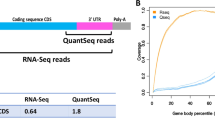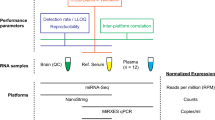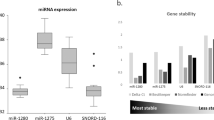Abstract
MicroRNAs are important negative regulators of protein-coding gene expression and have been studied intensively over the past years. Several measurement platforms have been developed to determine relative miRNA abundance in biological samples using different technologies such as small RNA sequencing, reverse transcription–quantitative PCR (RT-qPCR) and (microarray) hybridization. In this study, we systematically compared 12 commercially available platforms for analysis of microRNA expression. We measured an identical set of 20 standardized positive and negative control samples, including human universal reference RNA, human brain RNA and titrations thereof, human serum samples and synthetic spikes from microRNA family members with varying homology. We developed robust quality metrics to objectively assess platform performance in terms of reproducibility, sensitivity, accuracy, specificity and concordance of differential expression. The results indicate that each method has its strengths and weaknesses, which help to guide informed selection of a quantitative microRNA gene expression platform for particular study goals.
This is a preview of subscription content, access via your institution
Access options
Subscribe to this journal
Receive 12 print issues and online access
$259.00 per year
only $21.58 per issue
Buy this article
- Purchase on Springer Link
- Instant access to full article PDF
Prices may be subject to local taxes which are calculated during checkout






Similar content being viewed by others
Accession codes
Primary accessions
ArrayExpress
Gene Expression Omnibus
Change history
30 July 2014
In the version of this article initially published, the author Linda Wong was omitted from the author list. The error has been corrected in the HTML and PDF versions of the article.
References
Cortez, M.A. et al. MicroRNAs in body fluids–the mix of hormones and biomarkers. Nat. Rev. Clin. Oncol. 8, 467–477 (2011).
Jensen, S.G. et al. Evaluation of two commercial global miRNA expression profiling platforms for detection of less abundant miRNAs. BMC Genomics 12, 435 (2011).
Wang, B. et al. Systematic evaluation of three microRNA profiling platforms: microarray, beads array, and quantitative real-time PCR array. PLoS One 6, e17167 (2011).
Kelly, A.D. et al. Next-generation sequencing and microarray-based interrogation of microRNAs from formalin-fixed, paraffin-embedded tissue: preliminary assessment of cross-platform concordance. Genomics 102, 8–14 (2013).
Kolbert, C.P. et al. Multi-platform analysis of microRNA expression measurements in RNA from fresh frozen and FFPE tissues. PLoS One 8, e52517 (2013).
Leshkowitz, D., Horn-Saban, S., Parmet, Y. & Feldmesser, E. Differences in microRNA detection levels are technology and sequence dependent. RNA 19, 527–538 (2013).
Pradervand, S. et al. Concordance among digital gene expression, microarrays, and qPCR when measuring differential expression of microRNAs. Biotechniques 48, 219–222 (2010).
Git, A. et al. Systematic comparison of microarray profiling, real-time PCR, and next-generation sequencing technologies for measuring differential microRNA expression. RNA 16, 991–1006 (2010).
Meyer, S.U., Kaiser, S., Wagner, C., Thirion, C. & Pfaffl, M.W. Profound effect of profiling platform and normalization strategy on detection of differentially expressed microRNAs–a comparative study. PLoS ONE 7, e38946 (2012).
Shippy, R. et al. Using RNA sample titrations to assess microarray platform performance and normalization techniques. Nat. Biotechnol. 24, 1123–1131 (2006).
Dittmar, K.A., Goodenbour, J.M. & Pan, T. Tissue-specific differences in human transfer RNA expression. PLoS Genet. 2, e221 (2006).
Irizarry, R.A. et al. Summaries of Affymetrix GeneChip probe level data. Nucleic Acids Res. 31, e15 (2003).
Irizarry, R.A. et al. Exploration, normalization, and summaries of high density oligonucleotide array probe level data. Biostatistics 4, 249–264 (2003).
Geiss, G.K. et al. Direct multiplexed measurement of gene expression with color-coded probe pairs. Nat. Biotechnol. 26, 317–325 (2008).
Lefever, S. et al. RDML: structured language and reporting guidelines for real-time quantitative PCR data. Nucleic Acids Res. 37, 2065–2069 (2009).
Mestdagh, P. et al. A novel and universal method for microRNA RT-qPCR data normalization. Genome Biol. 10, R64 (2009).
Breitling, R., Armengaud, P., Amtmann, A. & Herzyk, P. Rank products: a simple, yet powerful, new method to detect differentially regulated genes in replicated microarray experiments. FEBS Lett. 573, 83–92 (2004).
Acknowledgements
We thank J. Nuytens for preparing all RNA samples and E. Lefebvre and T. Demoor for statistical and mathematical support. P. Mestdagh is supported by the Fund for Scientific Research Flanders (FWO); J.V. is supported by the Ghent University Research Fund (BOF).
Author information
Authors and Affiliations
Contributions
P. Mestdagh, J.V. and T.G. designed the study; P. Mestdagh and J.V. performed data analysis and wrote the manuscript; and N.H., L.B., D.A., N.B., C.C., D.C., P.D., M.D., L.D., S.D., Y.F., S.F.-S., B.G., J.G., C.G., E.L., K.Y.L., S.L., P. Mouritzen, A.N., S. Patel, S. Peiffer, S.R., G.S., D.S., J.M.S., E.J.S., S.S., U.U., V.V., F.S. and T.P. produced miRNA expression data. All authors approved the final version of the manuscript.
Corresponding author
Ethics declarations
Competing interests
D.A. and P. Mouritzen are employed by Exiqon; N.B., C.C., K.L., S.P atel., E.S. and U.U. are employed by Life Technologies; D.C., Y.F. and D.S. are employed by Quanta Biosciences; P.D. and S.F. are employed by Agilent Technologies; M.D. and J.G. are employed by Affymetrix; L.D. and C.G. are employed by NanoString Technologies; S.D. and S.S. are employed by WaferGen; E.L. and J.S. are employed by Qiagen; S.L. and G.S. are employed by Illumina. MiRNA profiling experiments were performed at the expense of Exiqon, Life Technologies, Agilent Technologies, Quanta Biosciences, Qiagen, WaferGen, Illumina and NanoString Technologies.
Supplementary information
Supplementary Text and Figures
Supplementary Figures 1–10, Supplementary Tables 1–3 and Supplementary Notes 1–13 (PDF 15764 kb)
Supplementary Data
miRQC qPCR Data (ZIP 920 kb)
Rights and permissions
About this article
Cite this article
Mestdagh, P., Hartmann, N., Baeriswyl, L. et al. Evaluation of quantitative miRNA expression platforms in the microRNA quality control (miRQC) study. Nat Methods 11, 809–815 (2014). https://doi.org/10.1038/nmeth.3014
Received:
Accepted:
Published:
Issue Date:
DOI: https://doi.org/10.1038/nmeth.3014
This article is cited by
-
Age-related noncanonical TRMT6–TRMT61A signaling impairs hematopoietic stem cells
Nature Aging (2024)
-
Biomarkers of obesity-mediated insulin resistance: focus on microRNAs
Diabetology & Metabolic Syndrome (2023)
-
Single cell quantification of microRNA from small numbers of non-invasively sampled primary human cells
Communications Biology (2023)
-
Nanopore sequencing of DNA-barcoded probes for highly multiplexed detection of microRNA, proteins and small biomarkers
Nature Nanotechnology (2023)
-
Rapid and accurate quantification of isomiRs by RT-qPCR
Scientific Reports (2022)



